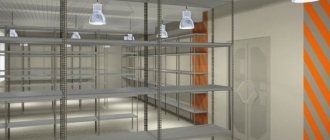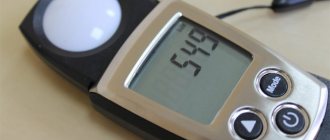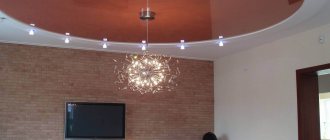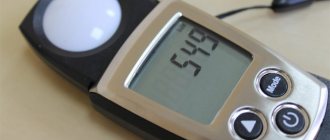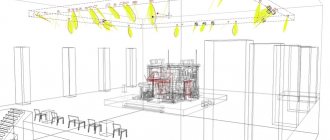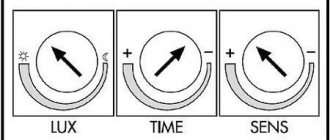The popularity of LED light sources is increasing every day, which is due to several factors at once - cost-effectiveness, a light spectrum that is as close as possible to daylight radiation, a monthly reduction in the cost of products and an increase in electricity tariffs. Before replacing one equipment with another, it is necessary to perform a calculation of LED lighting to find out how many lamps and what power will replace the old halogens or housekeepers. If, when operating incandescent lamps, 60/100 W products were used, then in the case of LEDs such values are unacceptable. Also, before installation, you need to determine the total luminous flux.
Why is the calculation needed?
It is required to create the most comfortable living conditions due to high-quality and optimal lighting of the entire area of the room. Too strong or weak light flux negatively affects the functioning of the visual apparatus, leading to excessive fatigue, tension or nervousness. Such discomfort will affect the mental state of the person, who will become more irritable and less efficient.
The reference lighting is considered to be solar daylight. With proper calculation, an artificial lighting system consisting of various lamps should bring the light as close as possible to natural light. SNiP specifies lighting standards for each individual room. It is important to take all these values into account when making calculations.
Advantages of LED technologies
Nowadays you won’t surprise anyone with LED lamps. Products with good light output, high efficiency and low energy consumption confidently continue their march across the planet by leaps and bounds. They are gradually replacing the recently popular compact fluorescent lamps, and are also replacing incandescent lamps, the efficiency of which has long been a thing of the past.
Almost the only drawback of LEDs is their fairly high cost. However, their advantages over traditional sources of photon radiation will allow them to recoup their high cost many times over.
The main positive qualities of LED lighting devices include:
- long service life (from 50 thousand to 100 thousand hours);
- absence of mercury vapor and other toxic substances;
- reliability and safety of use;
- compact dimensions;
- resistance to mechanical vibrations;
- lack of external ballasts;
- environmental safety;
- possibility of operation in conditions of high humidity;
- reliable starting at low temperatures;
- good color rendering index;
- high efficiency of luminous flux (in modern samples - from 60 to 140 Lm/W).
Room lighting standards
The radiation intensity in the apartment varies depending on the purpose of the room. When creating equally bright or more diffuse lighting in each room, the comfort of living in the house significantly decreases.
We list the average illumination levels for different rooms in apartments or a private house with a ceiling height of 2-2.5 m:
- living room – 150 lux;
- bedroom – 200 lux;
- hallway and corridor – 100-200 lux;
- study – 300 lux;
- children's room - 200 lux;
- kitchen – 150-200 lux;
- bathroom – 50-150 lux.
These are only approximate values, since to determine sufficient brightness it is necessary to take into account the overall dimensions of the room (height, width, length) and the type of lighting (primary, additional, functional or decorative lighting).
When using a functional lighting system, the brightness of the device should be slightly higher. In the case of decorative lighting, low-power lamps are used.
Correct placement of lamps
Before attaching the lamps, you need to decide on their location. There are several functional areas in the bathroom, each of which takes into account:
It is worth noting that there are many options for organizing lighting in a large bathroom. However, today the most relevant is three-level lighting, which involves the placement of lamps of different types at different distances from the floor.
Local (spot) lighting in the bathroom is formed by wall sconces or spots located near mirrors or along the perimeter of the room. They are connected from a separate switch and used to obtain greater light output.
The third level serves as decorative lighting and is necessary to create a relaxing, intimate environment. These can be ready-made LED light sources built into a shower stall or bathtub. Or projects made on the basis of RGB LED strips, allowing you to set the brightness and color of the radiation according to your own mood.
How to achieve uniform lighting?
When choosing a location for installing LED devices, you need to focus on the amount of luminous flux. The higher the value of this parameter, the greater the distance between the lamps. To cover the entire area of a room or a specific area, you first need to calculate the required number of lamps.
To create uniform lighting, you need to use different types of lighting fixtures. There are many combinations:
- A chandelier is installed as a central lamp. The luminous flux is supplemented by point sources scattered across the ceiling in different patterns.
- Several main light sources are attached to the ceiling, which are complemented by decorative lighting made from flexible tape.
- Only point devices with the most suitable characteristics are mounted on the ceiling. The chandelier is not used.
Proper lighting of the production area
By type, industrial lighting of a room (like any other) is divided into natural and artificial.
Natural light is the most valuable: the human eye is most adapted to it. It enters the building through windows and other transparent building structures (for example, aeration skylights).
Daylight
Types of artificial lighting:
- general;
- local;
- combined.
Local lighting is not used by itself; it is used only in combination with general lighting. A suitable lighting device can be portable or stationary. The light spot from it does not even illuminate the areas adjacent to it.
Combined building illumination method
Combined - required when workers perform high-precision operations that do not allow the appearance of sharp shadows from any objects.
Only combined lighting can ensure compliance with safety standards at the enterprise
General - organized in workshops with the same type of work (for example, in foundries). There are cases when combined lighting is simply not possible to organize.
For maximum efficiency, you can illuminate technical or street areas with devices with motion sensors to turn on the lights.
Light level detection
Let's look at how to calculate the glow intensity for a specific room. The formula is as follows: Ф = R * S * L, where:
- R – illumination per 1 sq. m;
- S – area of the room;
- L – safety factor.
The safety factor is related to the mounting height of the luminaires and the reflectivity of the walls, ceiling and floor on which the light falls. In living rooms, when using LEDs, the safety factor is 1.1.
For example, consider calculating the glow intensity in a bedroom with an area of 8 square meters. m. Illumination (R) is taken from the list above (chapter “Room illumination standards”).
As an example, consider the calculation of LED bedroom lighting:
- F = 200 * 8 * 1.1 = 1760 lm
Based on the obtained value, we come to the conclusion: the total value of the luminous flux of all light sources used should be close to 1760 lm. We remind you of the negative effects of both excessive and insufficient lighting.
How to determine how many lamps are needed for a specific room
Even using the basic information outlined above, you can calculate how many spotlights will be needed in the room. There are simple tips for this:
- Determine the area of the room by measuring the length and width.
- Using the table, determine the norm of illumination per square meter. Multiply by area to get an approximate result.
- Select the lamps, then divide the final number from the point above by the power of one element. If the value is fractional, it is better to round up.
- If there are several options with different powers, it is worth using less powerful lamps and installing more of them. Then the light will be more uniform and more comfortable for the eyes.
Isolating a work area using spotlights.
What data is needed to calculate the illumination level
The formula above is general and indicates the average illumination value, but for more accurate calculations you need to use several additional parameters.
Let us list the main variables and constants used in the formulas for calculating the illumination of a specific room:
- The area of the room is the length times the width. This formula is relevant if the calculation is performed for a rectangular room. To calculate the area of a room with more complex architecture, you need to mentally divide it into several zones consisting of regular geometric shapes, calculate the area of each and sum up the resulting values.
- An adjustment factor that allows you to take ceiling heights into account when calculating. Light spreads in different directions - not only across the area, but throughout the entire volume of the room, so the brightness will also depend on the height of the ceilings. For this purpose, a separate table of correction factors was created. For example, in a room with a ceiling height of 2.5-2.7 m the coefficient is 1, up to 3 m – 1.2, up to 3.5 m – 1.5. For higher rooms the correction factor is 2.
- Light level. The amount of luminous flux per 1 sq. m for a specific room. Above we have already indicated the values for different living rooms. It is measured in lux (lx).
Upon general consideration, the following relationship is observed:
- from 20 to 50 lux for utility rooms, toilets, bathrooms, basements and corridors;
- from 150 to 300 lux for other living rooms, while for the bedroom, as for the rest room, the minimum level is necessarily set.
For the most accurate calculation, you can use parameters such as dust levels and shades of finishing materials. The latter affect the safety factor.
Features of suspended ceiling lighting
Calculation of the number of lamps in a suspended ceiling must be carried out taking into account some of the features of this material. This is due to the fact that the characteristics of the canvas differ from traditional options. It is worth considering the following:
- Glossy surfaces reflect light much better than any other ceiling covering. This applies to both light and dark options. Lamps on such bases provide excellent quality of light, especially if positioned correctly.
- The canvas does not tolerate overheating well, so it is better not to use incandescent lamps and halogen options. The minimum distance from the suspended ceiling to the ceiling when using such options should be 20 cm, which is not very good, since a lot of space is lost.
- Installation is also different, since the bases for spotlights are attached before the ceiling is laid. You need to make a clear diagram in advance and determine the location in order to connect the wires and secure platforms of the appropriate size.
Calculation of illumination of premises for various purposes
It is not enough to take into account illumination according to SNiP standards, because specific values depend on individual preferences and the purposes for which the room will be used. If you are going to write and read a lot, then the brightness should be as high as possible, while for a corridor this parameter is less important.
When using incandescent lamps, use the data in the table below:
| Incandescent lamp power, W | Luminous flux, lm |
| 20 | 250 |
| 40 | 400 |
| 60 | 700 |
| 75 | 900 |
| 100 | 1200 |
| 150 | 1800 |
Thus, returning to our calculation in the chapter “Determining the level of illumination” and remembering the obtained value of the luminescence intensity for a bedroom of 8 square meters. m (1760 lm), you can determine how many lamps are needed for high-quality lighting of a given room: seven 20 W lamps, four 40 W lamps, two 75 W lamps or one 150 W lamp.
Requirements and wishes for lighting arrangement
Before you begin planning and calculating the lighting system of a room, it is necessary to formulate what basic criteria it must meet.
The main ones are:
- Comfortable illumination, that is, light enough for reading, communication, homework, but does not hurt the eyes. This indicator is different for everyone, as it depends on the state of vision, habits and preferences.
- Convenient placement of lamps that should provide light to the entire area of the room, but the level of illumination may differ in different parts of the room.
- Cost-effectiveness, namely, the amount of the monthly payment for electricity, the cost of the light bulbs themselves (for one and for the entire number), the service life of the light bulbs (how often they will have to be purchased).
If you take into account all these requirements, then the optimal solution will be the choice of LED lamps. In terms of light level, they are equal to incandescent lamps, but they consume significantly less electricity and last for several years. Compared to energy-saving fluorescent lamps, LED analogs are more compact in shape and have a pleasant glow. Now it is necessary to calculate the illumination of the room with LED lamps in order to calculate how many and what power of lamps is needed for sufficient lighting.
Calculation of lighting with LED lamps
LED light sources differ significantly from their counterparts. There is a printed circuit board responsible for the control system, and a driver that reduces and stabilizes the voltage entering the LED diodes. To simplify the process of switching from incandescent lamps to LED emitters as much as possible, manufacturers try to stick to classic forms. The most popular varieties today are the “pear” and “corn” varieties. “Candle” is used less frequently, but is in stable demand.
Pear lamp
“Pears” are LED emitters whose shape resembles conventional filament lamps. The body of the product consists of a transparent hemisphere (partially painted, with a layer of phosphor on the surface) and ribbed opaque plastic. The presence of fins provides natural cooling. At the point of contact of the two parts there is a diode board directed in one direction. This design and features of LEDs lead to a significant reduction in the light dispersion angle to 180 degrees. instead of almost 360 for incandescent lamps (the “dead zone” of these devices is only near the base).
Corn lamp
The design of this lamp involves installing the diode board perpendicular to the base, along the axis. It is made in the form of a plate, tube with a round, square or polygonal cross-section. The LEDs are located on the front part, and the electronics are hidden inside the base (next to it or inside the tube).
The product got its name due to the similarity of the board on which the diodes are installed to an ear of corn. In this case, the dispersion angle is significantly higher, since the “dead zones” are located only near the base and on the opposite edge of the bulb. When placing LEDs at the end, the last “zone” may be completely absent.
Candle lamp
The "candle" is often called a compromise between the "pear" and "corn" designs. Compared to the “pear”, the dispersion angle is much wider, but the power and overall dimensions are reduced. Basically, such products are used in table lamps and local lighting systems for rooms/small areas.
Why LEDs?
A few years ago, many of our compatriots began to use energy-saving fluorescent lamps with E14 and E27 sockets. But now the turn has come for more efficient devices - LEDs, which demonstrate lower energy consumption (compared to incandescent lamps - 10 times, compared to fluorescent lighting devices - 3 times).
Advantages of LEDs
The undeniable advantages of LED lamps have made them popular all over the world. Such lamps are many times more effective than conventional incandescent lamps and devices emitting fluorescent light.
Advantages of LED lamps:
- energy saving;
- creating light as close to daylight as possible;
- Possibility of use both indoors and outdoors (street lighting);
- higher voltage swing - lamps will operate in the range from 80 to 230 Volts;
- increased service life - up to 25 years;
- environmentally friendly, since they do not emit harmful substances into the air;
- the ability to control the backlight using a remote control;
- silent operation unlike fluorescent lamps.
The disadvantages of such lighting devices can be considered the increased price and low color rendering index, reaching 85-90%.
Inaccuracies and errors when calculating LED lighting
The formulas discussed cannot be called complete, since there are many more factors that influence the quality of light. We have listed some above, but they can be supplemented by a number of others:
- reflectivity coefficient of various finishing materials and surfaces;
- physical and technical parameters of a specific lamp;
- presence of diffusers and reflectors;
- room index;
- Room efficiency, etc.
It is impossible to achieve one hundred percent accuracy in calculations. Even if they are performed by highly qualified engineers, certain assumptions will still have to be made or generally accepted averages must be used. And the standards written in SNiP cannot be called strict and justified, since there will always be a difference between the desired and possible results.
Is the type of lighting and surface characteristics important?
The design of premises involves 3 types of lighting: accented, functional, general. Each of them affects illumination to a greater or lesser extent. Knowing the characteristics of the species, the required indicator is calculated.
Accent lighting is used in the interior to highlight objects and create the desired atmosphere. Various lighting effects and shades are used, obtained from economical sources: LED strips, small lamps. There are no special requirements for the level of illumination.
Functional lighting is used for additional illumination of the workplace in the kitchen, workshop, office, near the mirror, etc. Designers use it to zone rooms.
The purpose of general lighting is to provide the amount of light needed for a room. Sources are placed on the ceiling, walls, using floor lamps, etc. The type of lamps does not matter
General lighting is used when calculating the required level, without taking into account accented lighting; sometimes local lighting is taken into account
Sometimes, after all the calculations, it turns out that the illumination is insufficient. This happens when the reflectivity of surfaces is not taken into account. If the walls or floor of the room are dark, the ceiling is dull, the illumination decreases. For example, the lighting above the desk is bright and sufficient for work. For reading a book on the sofa, the light intensity is not enough, because the rays are poorly reflected from dark walls.
Formula for calculating the reflection coefficient.
There is a reflectance coefficient (RC), which depends on the color of the surface:
- white walls and ceiling reflect 70% of light;
- light - 50%;
- gray - 30%;
- dark - 10%.
Black surfaces do not reflect anything, absorbing rays. Determine illumination taking into account reflection using tables. There is a simplified formula according to which the average reflective coefficient is equal to the sum of the RC of the walls, ceiling, floor, divided by 3. This coefficient is used in calculations.
Which lamps to choose for lighting
The critical parameters on which the quality of lighting depends are:
- color temperature;
- diffuser type;
- light flow.
Colorful temperature
Traditionally, color temperature can be divided into three main ranges:
- warm white light – 2500-3000 K;
- white – 3000-4200 K;
- cool white – 4500 K and above.
The higher the color temperature, the brighter the lamps shine, while it is not recommended to use too cold shades in the bedroom and rest rooms, and warm shades in reading areas.
Diffuser type
LED lamps use frosted or transparent lenses. In the first case, the light is distributed as evenly as possible, but losses can reach 20-30%. Recommendations for use are simple: if it is necessary to illuminate rooms with a large area, you need to use transparent diffusers; for table or wall lamps - matte ones.
Light flow
When choosing an LED lamp, pay attention to its rated luminous flux. Its value depends on a number of factors and the country of origin. On average, for diode products with a power of 4.8 W, the following dependence is observed:
- lamps from China – 240 lm;
- Taiwan - 380-420 lm;
- Europe – 500 lm and above.
Do not forget that the wattage of a lamp with warmer light should be 20-25% higher than that of sources with cool white light.
The overall illumination of the room, of course, depends on the number of LED lamps, but these are not all the parameters that need to be taken into account when choosing. Be sure to focus on the color temperature, luminous flux and power of the product. To create a uniform glow using LEDs, it is important to perform the most accurate calculations so that it does not turn out that one room is lit too brightly, while another is sorely lacking in light.
Think seven times before calculating lighting
Why do you need light calculations and what you should know
A comfortable environment for a person in the house is created by artificial light from lamps. If there is insufficient or excess sensation of light, additional visual strain and eye irritation arise, the need for glasses appears, resources decrease with a loss of strength, and well-being worsens. Therefore, a mandatory calculation of the lighting of the room is made, compliance with established sanitary standards is determined, and the optimal option for light sources close to natural lighting is selected.
According to the design and methods of distribution of the necessary light in the house, in rooms, everywhere, electric lighting is divided into 3 types: general, accented, local. It can be difficult to understand the calculations for general lighting with LED lamps for a residential building. The calculation will require an understanding of the basic parameters and definitions of the light object.
Basic light characteristics, units of measurement
Light can be measured and described, like many other things in “light.” In physics, illumination is an “integral” quantity, determined by many parameters studied by the science of photometry.
Table 1. Used physical concepts of light, symbols and units of measurement:
| Characteristic | Designation | Unit |
| Light flow | F | Lm lumen |
| The power of light | I | Kd candela, "candle" |
| Brightness | L | Kd/m² nit (nt) |
| Illumination | E | LK luxury |
| Light temperature | K | Kelvin |
| Luminous output | H | lm/W |
Basic parameters of light emission Source infourok.ru
Lumens of light flux are wave energy from a source emitted in all directions, perceived as “brightness” by visual sensation. According to the distribution of light rays, light fluxes can be reflected, diffused, or direct. The greater the number of lumens is determined, the greater the total light flux taken into account.
Luminous intensity (I) is similar to the spatial density of the light flux, its intensity. When determining I, the luminous flux (Ф) is divided by the solid angle (ꭥ) in steradians in the direction of the flux.
The concept of illumination relates the amount of light (luminous flux) per area of the illuminated surface (E = Ф/S). The magnitude of lux depends directly on the luminous intensity of the source and inversely proportional to the square of the distance to the source (provided that the flux is perpendicular to the surface).
When determining the values of light, their interrelation and qualitative difference can be traced: that the lamp itself is brighter at high lumens, and the surface is more illuminated at sufficiently high lux values.
The source is characterized by the efficiency of converting electricity into light (luminous efficiency H). It is measured in lumens per watt.
Lighting quantities Source rusenergetics.ru
See also: Catalog of companies that specialize in electrical work of any complexity
The exchange of energy (light emission) between an electrical source and an external room (by brightness) is essentially work in physical terms ( 1 Joule = 1 Watt * 1 sec ). Work is considered to be the radiation power multiplied by time. With a known average value of the luminous efficiency (H) of the lamp, the luminous flux can be approximately determined. The light source will be brighter with higher lighting power. From sources with equal luminous intensity (I), LED lamps consume less electrical power.
Comparison of light output of sources:
- Vacuum incandescent lamp with tungsten filament - from 8 to 10 lm/W..
- Halogen lamp – from 12 to 15 lm/W.
- Fluorescent lamp with voltage conversion in the base - from 50 to 70 lm/W.
- LED modern lamps – from 100-120 lm/W.
For the visual understanding of a subject, exposure to light and color is important for every person (especially for artists). A certain perception by the optic nerve of a specific established color of the spectrum fixes the concept of color.
Color temperature (K) refers to the color of light emitted. Regular temperature and color temperature are different concepts; near the sky in winter, in frost, the color temperature is 12000K, while that of a lit candle is 10 times less - 1200K.
Color temperature Source ds04.infourok.ru
Used in the practice of determining the color of white light:
- daylight – more than 5000 K,
- neutral – from 3300 to 5000 K,
- warm – less than 3300 K.
The eye is designed in such a way that the presence of blue tints in the source radiation reduces the brightness of its visual perception.
